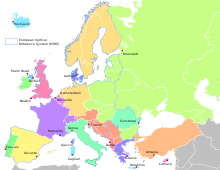Vertical datum

In
Commonly adopted criteria for a vertical datum include the following approaches:
- tidal datums;
- Datum of 2022set to be released that year by the National Geodetic Survey.
Prominent vertical datums in use by professionals include the National Geodetic Vertical Datum of 1929 and the North American Vertical Datum of 1988.
Methods
In common usage, elevations are often cited in height above sea level, although what "sea level" actually means is a more complex issue than might at first be thought: the height of the sea surface at any one place and time is a result of numerous effects, including waves, wind and currents, atmospheric pressure, tides, topography, and even differences in the strength of gravity due to the presence of mountains etc.
For the purpose of measuring the height of objects on land, the usual datum used is
A different principle is used when choosing a datum for
Conversely, if a ship is to safely pass under a low bridge or overhead power cable, the mariner must know the minimum clearance between the masthead and the obstruction, which will occur at high tide. Consequently, bridge clearances etc. are given relative to a datum based on high tide, such as Highest Astronomical Tide or Mean High Water Springs.
Sea level does not remain constant throughout
A geodetic vertical datum takes some specific zero point, and computes elevations based on the geodetic model being used, without further reference to sea levels. Usually, the starting reference point is a tide gauge, so at that point the geodetic and tidal datums might match, but due to sea level variations, the two scales may not match elsewhere. An example of a gravity-based geodetic datum is
Types
Common types of vertical datums include:[4]
- The surface of the datum ellipsoid, resulting in an ellipsoidal height
- The mean sea level as described by the gravity geoid, yielding the orthometric height[3][5]
Along with the latitude φ and longitude λ, the height h provides the three-dimensional geodetic coordinates or geographic coordinates for a location.[6]
To completely specify a location of a topographical feature on, in, or above the Earth, one also has to specify the vertical distance from the Earth's center or surface. The Earth is not a sphere, but an irregular shape approximating a biaxial ellipsoid. It is nearly spherical, but has an equatorial bulge making the radius at the Equator about 0.3% larger than the radius measured through the poles. The shorter axis approximately coincides with the axis of rotation. Though early navigators thought of the sea as a horizontal surface that could be used as a vertical datum, this is not actually the case. The Earth has a series of layers of equal potential energy within its gravitational field. Height is a measurement at right angles to this surface, roughly toward the Earth's center, but local variations make the equipotential layers irregular (though roughly ellipsoidal). The choice of which layer to use for defining height is arbitrary.
Examples
- Australia: Australian Height Datum
- Austria, Albania and former Yugoslavian republics: Metres above the Adriatic
- France: General levelling of France
- Germany: Normalhöhennull, preceded by Normalnull
- Great Britain: Ordnance Datum Newlyn
- Netherlands: Amsterdam Ordnance Datum, was also used by Prussia
- Switzerland: Metres above the Sea
- United States: National Geodetic Vertical Datum of 1929, North American Vertical Datum of 1988, and the difference of the two in VERTCON
- Global (geoid): Earth Gravitational Model (EGM), EIGEN-6C4 and others[7]
Chart datums

A
See also
- Datum reference
- Horizontal datum
- Levelling
- Reduced level
- Reference datum height
- Reference water levels
- Vertical Offshore Reference Frames
- Height above ground level
- Height above sea level
- Height above average terrain
References
- PMID 10348732.
- S2CID 28320895.
- ^ a b A guide to coordinate systems in Great Britain (PDF), D00659 v2.3, Ordnance Survey, Mar 2015, retrieved 2015-06-22
- ^ Taylor, Chuck. "Locating a Point On the Earth". Archived from the original on 3 March 2016. Retrieved 4 March 2014.
- ^ DMA Technical Report Geodesy for the Layman, The Defense Mapping Agency, 1983
- ^ Kwok, Geodetic Survey Section Lands Department Hong Kong. "Geodetic Datum Transformation, p.24" (PDF). Geodetic Survey Section Lands Department Hong Kong. Archived from the original (PDF) on 1 February 2016. Retrieved 4 March 2014.
- ^ Reißland, Franz Barthelmes, Elmas Sinem Ince, Sven. "ICGEM International Center for Global Gravity Field Models". icgem.gfz-potsdam.de.
{{cite web}}: CS1 maint: multiple names: authors list (link) - ^ a b Australian Bureau of Meteorology National Tide Centre Glossary (retrieved 30 April 2013)
- ^ Sjofartsverket: Mean Sea Level
External links
- Tidal Datums, produced for National Geodetic Survey
